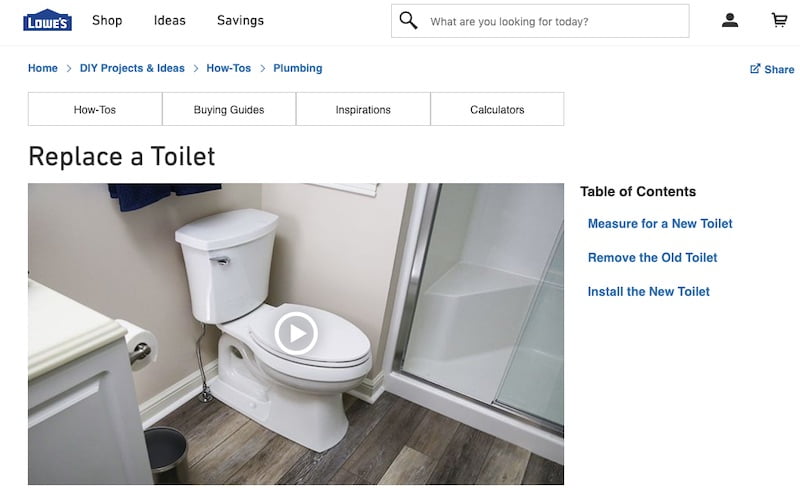Attracting links to ecommerce product pages is difficult. Links to how-to pages, however, are much easier. Sixty-three quality sites have linked to this instructional page from Lowe’s on replacing a toilet.
Link-building is tough. It’s especially tough for ecommerce sites. Long gone are the days when consumers linked to products. Today, getting a link to a category or product page takes a bit of finesse. Moreover, crafting a link placement that appears natural to Google can be tricky.
Many ecommerce sites, even the most popular, don’t have many backlinks to product and category pages. Yet, they appear to rank well in organic search results. This is often because all ecommerce sites struggle with attracting links. Thus it’s a level playing field, and Google relies on other signals.
But that doesn’t mean you shouldn’t be seeking links. It may be even more necessary.
Unequal Backlinks
Google realized at its inception that links from other websites could lead to better search results. Google reasoned that links are votes on importance. “Link popularity” is based on this concept — the page with the most links is arguably the most popular and, hence, “valuable.”
As search optimizers understood the power of backlinks, they began soliciting links from seemingly everywhere. This violated the editorial concept on which Google based link signals. Forum boards. Directories. Press releases. Social media.
Years ago, links from these types of websites worked well. And they were inexpensive. Today, such links could indicate spam and invite scrutiny from Google.
But Google doesn’t want to ignore backlinks. Instead, it built algorithms to find and neuter the spammiest of links. The Penguin-series of updates and penalties, starting in 2011, is such an algorithm.
Thus securing worthwhile backlinks is now time-consuming and costly. Many ecommerce companies I talk to don’t have a link-building budget (or any budget for search engine optimization).
Link-building
Often, merchants view their blogs as link magnets. But let’s be honest. How often do you encounter a valuable, link-worthy blog on an ecommerce site? Certainly they exist, but they aren’t plentiful.
How-to pages, however, can be effective if well executed. Consider examples from three prominent home improvement companies: Lowe’s, Home Depot, and Ace Hardware. Each sells plumbing components.
How often do you encounter a valuable, link-worthy blog on an ecommerce site?
Ahrefs tells us that almost 9,000 people monthly in the United States search for “how to replace a toilet.” Google has rich snippets for the phrase, and a “people also ask” for the question. If I were assisting one of the three companies, I’d be interested in putting my store in front of these searchers.
But in today’s SEO climate, I know there’s virtually no chance my product page would rank for this type of query. Google doesn’t want to show products.
Wisely, all three retailers created a page for helping potential customers replace a toilet. Let’s break each one down.
First is Ace Hardware. Its “How to Install a Toilet” video page did not rank for me when I searched “how to replace a toilet.” The page (at time of writing) was extremely slow, which could be a contributing factor. But the page has very little text. It has no contextual links to related products. The embedded YouTube video might be helpful to consumers, but not to Google. Ahrefs shows one backlink (which was subsequently dropped) to this page. Ace Hardware is missing an opportunity.
Next is Home Depot, which ranked sixth for me. The page is much better than Ace Hardware’s version. Home Depot’s page contains a similar (but shorter) YouTube embed. But it also has helpful text. The user experience is improved with links to guides and related categories, as well as a step-by-step tutorial. Finally, Ahrefs says this page has earned links from 10 domains. The domains appear to be of low quality. But they still pass link equity to the page and on through the contextual category links. Home Depot can improve the rankings for this page by improving the copy and with a bit of outreach.
Finally, Lowe’s “Replace a Toilet” page ranked third in organic results. The page included a helpful YouTube video embed. The links to category pages are not contextual, but they are findable. And like Home Depot, the copy is thoughtful. The page feels slightly more comprehensive. But the real standout is the backlink profile. Ahrefs shows 63 websites linked to this page, including high profile sites such as WikiHow, eHow, and Hometalk.
Did Lowe’s reach out to these linking sites? Or did the sites link without Lowe’s prompting? I don’t know. But it’s clear that Lowe’s spent some real effort on the page.

